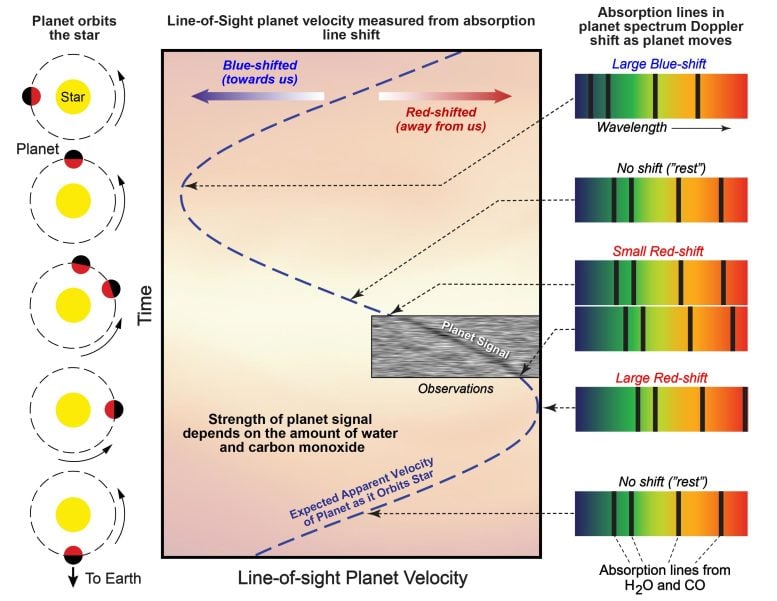An artist’s concept of a “hot Jupiter” extrasolar planet. Credit: NASA, ESA, and L. Hustak (STScI)
An international team of scientists, using the ground-based Gemini Observatory telescope in Chile, is the first to directly measure the amount of both water and carbon monoxide in the atmosphere of a planet in another solar system roughly 340 light-years away.
The team is led by Assistant Professor Michael Line of Arizona State University’s School of Earth and Space Exploration, and the results were published today (October 27, 2021) in the journal Nature.
There are thousands of known planets outside of our own solar system (called exoplanets). Scientists use both space telescopes and ground-based telescopes to examine how these exoplanets form and how they are different from the planets in our own solar system.
For this study, Line and his team focused on planet “WASP-77Ab,” a type of
By measuring the Doppler shift illustrated in the right column of this figure, scientists can reconstruct a planet’s orbital velocity in time toward or away from Earth. The strength of the planet signal as shown in the middle column, along the expected apparent velocity (navy dashed curve) of the planet as it orbits the star, contains information on the amounts of different gases in the atmosphere. Credit: P. Smith/M. Line/S. Selkirk/ASU
“These amounts were in line with our expectations and are about the same as the host star’s,” Line said.
Obtaining ultra-precise gas abundances in exoplanet atmospheres is not only an important technical achievement, especially with a ground-based telescope, it may also help scientists look for life on other planets.
“This work represents a pathfinder demonstration for how we will ultimately measure biosignature gases like oxygen and methane in potentially habitable worlds in the not-too-distant future,” Line said.
What Line and the team expect to do next is repeat this analysis for many more planets and build up a “sample” of atmospheric measurements on at least 15 more planets.
“We are now at the point where we can obtain comparable gas abundance precisions to those planets in our own solar system. Measuring the abundances of carbon and oxygen (and other elements) in the atmospheres of a larger sample of exoplanets provides much needed context for understanding the origins and evolution of our own gas giants like Jupiter and (function(d, s, id){
var js, fjs = d.getElementsByTagName(s)[0];
if (d.getElementById(id)) return;
js = d.createElement(s); js.id = id;
js.src = "https://connect.facebook.net/en_US/sdk.js#xfbml=1&version=v2.6";
fjs.parentNode.insertBefore(js, fjs);
}(document, 'script', 'facebook-jssdk'));
Read original article here
